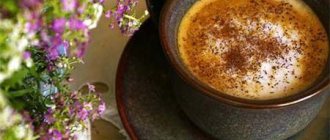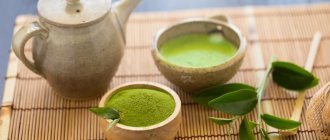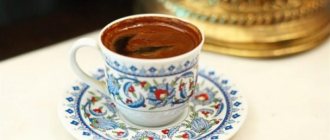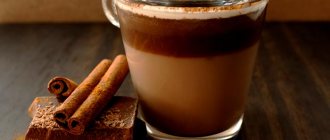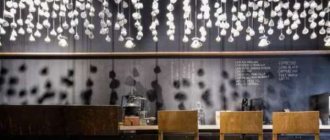Coffee traditions of different countries We can say with confidence that coffee is loved in all countries, because it is considered one of the most popular in the world. New ingredients are added to this unique drink, emphasizing the noble taste, or it is brewed in a special way. At the same time, the easiest way to get fragrant hot coffee is from a coffee machine, and the most difficult way is to brew it in a Turk from coffee beans yourself.
Interesting facts from history
Goats are considered the pioneers of coffee. Ethiopian shepherds noticed that when animals ate coffee trees, they were more animated. After this, the Ethiopians began to mix animal fat with grains and roll the mixture into balls. They were eaten mainly by nomads during their travels.
Coffee as a drink became popular thanks to Islam. It was originally used by Arab Sufi monks. In the 15th century it became available to ordinary people in the East. The grain was first grown commercially in Yemen. Thanks to close trade with other Arab countries, in the 16th century the drink appeared in Syria, Turkey, Egypt, and Persia. Since drinking alcohol was prohibited by religion, coffee became an excellent substitute. Coffee shops called “wisdom schools” appeared.
After some time, the authorities decided to close the establishments, as they believed that during gatherings people would unite against them. Over time, the ban was lifted. Coffee became an important export product for the Arab states, and everything possible was done to prevent other countries from starting to grow it. The grains were lightly fried or boiled in boiling water so that they could not germinate.
In the 17th century, a pilgrim from India was able to secretly smuggle several grains from Mecca. This was the first recorded case of smuggling. Over time, the first plantation appeared in India, after which other countries in Southeast Asia began growing it. At the same time, the Dutch colonies became the main suppliers of coffee to European countries. The attitude towards the drink in Europe was ambiguous. In Venice, a conflict even arose over this issue, in which Pope Clement VIII intervened. His choice was in favor of an invigorating drink. The first coffee shops began to appear in Germany, Holland, France and England.
The Dutch also brought coffee to the territory of present-day New York. Americans still preferred tea, but after the tax on it was increased, they gradually switched to another drink. The Dutch brought this product to South America. The first plantations were in Suriname and Guyana. Portugal decided to start growing coffee in Brazil, but they couldn't get the beans. One day, the wife of the governor of Guyana gave the Portuguese lieutenant colonel a bouquet of flowers. Coffee beans were hidden in it. This is how the first plantations appeared in Brazil.
World coffee production reached 90,000 tons by 1820. Half of this was produced by Brazil. Today, the world drinks more than 500 billion cups of the invigorating drink, almost half of them at breakfast. In terms of sales volume in world trade, this product ranks 2nd after oil. Interesting facts about coffee are connected not only with the history of the drink.
Unusual coffee traditions
There are certain standards for preparing popular types of coffee. Serving and traditions may differ in different countries. There are unusual drinks using coffee.
Traditions and customs in different countries:
- In Ethiopia, the invigorating drink must be prepared and served only by the owner of the house. Coffee should be served in order of precedence. If a guest refuses a treat, it is considered an insult. Cloves are added to the drink. It is customary to eat it with butter. Interestingly, salt is often added instead of sugar.
- The owner of a coffee shop in Iraq is considered a very respected person. In such establishments, men gather to socialize, watch TV and spend their leisure time. In this country it is indecent to drink more than 3 cups of coffee. A freshly prepared drink made from natural grains is valued.
- In Ecuador, coffee is brewed very strong, it is immediately mixed with sugar and cooled. This mixture becomes thick and is stored in the refrigerator. To make coffee, you just need to add the prepared mixture to boiling water to taste.
- Japan has long been considered a tea-consuming country. Today, coffee has become an everyday drink just like tea. In large cities there are many self-service machines on the streets. You can drink a natural drink in various establishments. The Japanese prefer lightly roasted beans. On October 1, the country celebrates a holiday called “Coffee Day.” In Japan, you can find Jamaican (the country is a leader in the import of elite BlueMountain coffee), Kenyan, Guatemalan, Brazilian and Nicaraguan coffee.
- Residents of Thailand prefer a strong drink. Mainly various finely ground and dark roasted varieties from Indonesia are used. A special feature of making coffee is mixing the beans with wheat, sesame or rice. Thais prefer a sweet drink with a lot of milk added.
- Malaysians drink mostly medium or dark roasted coffee beans. It can be served with milk or ice. In Malaysia, they sell packaged coffee mixed with sesame or cocoa.
- Coffee is the national drink in Yemen. The grains, along with the soft shell, are fried on a baking sheet and then crushed in a mortar. The drink is prepared in a special way: in a Dahl coffee pot, the coffee is brought to a boil twice, after which ginger is added. At the birth of a child, parents treat friends and relatives to an invigorating drink with cardamom. Sugar is rarely added to coffee; it is usually eaten with dates.
- The Vietnamese prefer to drink the drink cold. It has a high strength. Coffee is brewed in small portions and drunk in small sips through a special mesh filter made of metal.
- Damascus produces unusual coffee. It cannot be called a drink. A drop of a thick brown mixture rests on the bottom of the bowl. You need to lightly touch it with your tongue. First, a person feels a burning sensation, then there is vigor and a surge of strength.
- In Finland, a small piece of leipäjuusto cheese is placed at the bottom of the cup. Coffee is poured on top. As a result of exposure to high temperature, the cheese melts. The taste of the drink is unusual, slightly sweet. After the coffee is drunk, the remaining cheese is eaten.
- In Greece, there is a tradition: if a girl makes her boyfriend coffee with thick foam, it means she likes the young man.
Select and roast your beans with a master roaster in Hawaii
When we mention the Hawaiian Islands, the imagination draws pictures of excellent beaches, however, if we are talking about Hawaiian coffee, then we should mentally transport ourselves to the mountains.
Mountain Thunder Coffee Plantation is located in the Kona area of the Big Island, which is the most famous coffee producing area on the islands. The highest point of the plantation is located at an altitude of about 1 thousand meters, which is 60 meters higher than the point that was previously considered the highest place for food preparation. However, this height is ideal for growing amazing coffee.
Mountain Thunder offers tours that teach how Kona coffee is grown, harvested, ground and sorted. You can also try your hand at being a coffee roaster.
This profession is in the top 10 among all food production jobs. Under the supervision of an experienced professional, you can roast your coffee cherries until they are perfect beans ready for coffee.
Little known facts
Drinking coffee every day, few people are interested in the history of the drink, traditions and rituals associated with it. In addition, there is a lot of information that will be of interest to connoisseurs.
Little-known useful facts about coffee:
- — a lethal dose of caffeine for humans is contained in approximately 100 cups of the drink;
- — the optimal daily intake that will have a positive effect on health is 500 mg of natural coffee;
- — light roasted beans contain more caffeine than dark roasted beans;
- — the optimal temperature for brewing coffee is 95-98 degrees;
- — Arabica contains approximately 1% caffeine (mild taste), Robusta contains 2% caffeine (bitter taste);
- — unroasted grains can be stored for about a year under optimal conditions without losing their taste; after roasting, the positive properties disappear after two days;
- — coffee contains more than 800 different aromatic compounds;
- — one cup of the drink contains 300 antioxidants, they can stay in the body for a month;
- — with regular consumption, fat burns 20% faster (with physical activity and diet);
- — a cup of black natural coffee has 0 calories;
- — 70% of coffee lovers in the world drink Arabica, 30% drink Robusta;
- — the invigorating drink contains about 1200 chemical compounds and substances;
- - you can brew tea from the leaves of the coffee tree, which contains more antioxidants and less caffeine compared to regular tea;
- - the most expensive coffee (from 250 to 1200 dollars / kg) - kopi luwak (Indonesia, Philippines, Vietnam, India), beans are collected from musang excrement, washed, dried and made into a drink;
- — The International Olympic Committee classifies caffeine (a dose of more than 5 cups) as a prohibited substance;
- - at very large doses, the drink can cause hallucinations;
- - caffeine can enhance the effects of painkillers (aspirin, paracetamol).
Watch death over a cup of coffee in Thailand
In the Thai capital Bangkok, there is a cafe that invites visitors to “die” before drinking a life-giving caffeine-filled drink. At Kid Mai Death Awareness, the area is divided into zones, one where you can plan your funeral, another where there's a real coffin where you can climb in to savor your discounted drink. But keep in mind that the coffin lid will be closed! This place is specially created for those who say they will die without a morning cup of coffee.
By all accounts, Kid Mai Death Awareness is more art than classic cafe. It represents Buddhist teachings and philosophy. It was founded by Veranut Rojanaprapa, an assistant professor at St. John's University in Bangkok. According to the owner, it reduces greed and anger by making people realize that one day they will disappear.
Fortunately, a fake death awaits you in the cafe, because the coffin lid opens after 3 minutes, which is enough for you to enjoy your drink. At Death Awareness you'll find a "Last Day" espresso or "Another Year Has Gone" latte, as well as other themed coffees.
4
Amazing Facts About Coffee
Coffee is one of the most popular drinks in many countries. Grains are used in various fields. There are many amazing stories associated with coffee. Some of the data is simply amazing.
Interesting facts about coffee:
- — the height of the coffee tree is about 9 m, but only three-meter ones are found on plantations, to make it easier to collect the fruits;
- — grains are picked by hand, one person collects about 7 baskets (100 kg each) per day;
- — workers’ payment for one basket ranges from $2 to $10, and after drying and frying, the cost of the basket increases to $110;
- — the life of one coffee tree can reach 70 years;
- — coffee grows in a narrow geographical zone, between the tropics of Capricorn and Cancer;
- - instant drink was invented in 1906 by the Belgian George Washington;
- — there are 300 different devices for brewing, and 1,200 devices for grinding, roasting and other manipulations with coffee beans;
- - in Las Vegas in 2010, the largest cup of coffee was prepared, which consisted of 35,000 servings;
- — from 4000 pieces of beans, the output is 1 kg of finished coffee beans;
- — in Brazil, in Sao Paulo, a monument was erected to the coffee tree;
- — Finns are record holders for drinking the drink, accounting for 12 kg per person per year;
- — in 2011, coffee-scented stamps were released in Brazil;
- — in England, in the city of Banbury, there is an unusual power plant, its uniqueness is that it runs on coffee grounds.
Mexico
Spicy food-loving Mexicans love spicy coffee. To prepare a Mexican drink, any hot spices are suitable - cinnamon, cloves, cardamom, anise. Everything is mixed with ground coffee and sugar, filled with water and simmered over low heat in a special clay pot. The drink is filtered before drinking. This is the kind of coffee that soldiers drank during the Mexican Revolution for cheerfulness and pleasure. It is in clay pots that this natural energy drink reveals the whole bouquet of aromas.
